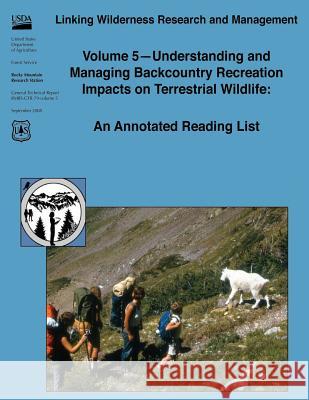Linking Wilderness Research and Management: Volume 5 - Understanding and Managing Backcountry Recreation Impacts on Terrestrial Wildlife: An Annotated » książka
Linking Wilderness Research and Management: Volume 5 - Understanding and Managing Backcountry Recreation Impacts on Terrestrial Wildlife: An Annotated
ISBN-13: 9781480172289 / Angielski / Miękka / 2012 / 80 str.
Linking Wilderness Research and Management: Volume 5 - Understanding and Managing Backcountry Recreation Impacts on Terrestrial Wildlife: An Annotated
ISBN-13: 9781480172289 / Angielski / Miękka / 2012 / 80 str.
(netto: 64,58 VAT: 5%)
Najniższa cena z 30 dni: 67,62
ok. 16-18 dni roboczych
Dostawa w 2026 r.
Darmowa dostawa!
The large increase in outdoor recreation activity over the last 50 years has been recognized as a potentially serious threat to North American wildlife populations. Threats to wildlife in wilderness are a concern to backcountry recreationists as well as the American public. The protection of wildlife habitat and endangered species was one of the most highly valued benefits of wilderness according to a telephone survey of approximately 1,900 people in the United States (Cordell and others 1998). Many backcountry recreation users cite the opportunity to view wildlife as an important part of their wilderness experience. Threats to wildlife in wilderness are also a concern for wildlife preservation. Wilderness often provides a refuge for wildlife amid a matrix of more intensively developed lands, and is especially valuable for wide-ranging species that are sensitive to human disturbance and those that depend on special habitats found predominantly in wilderness (Hendee and Mattson 2002). Impacts of recreation on wildlife include increased energetic demands during critical periods of the year, loss of habitat through avoidance of areas of human activity, exposure to predators while avoiding humans, and loss of habitat through changes in vegetation resulting from recreation activities (Knight and Gutzwiller 1995). If widespread, cumulative impacts on individuals of a species may ultimately affect local and regional populations. Changes in species' populations may affect wildlife communities, especially if the impacted species have strong interactions with other species. The management of wilderness recreation impacts on wildlife in designated wilderness is complicated by the potentially conflicting mandates of The Wilderness Act of 1964 Public Law 88-577]. The Act mandates the preservation of natural conditions in wilderness while requiring managers to provide opportunities for primitive recreation. However, when recreation affects wildlife species, populations, or communities, it can hinder the preservation of natural conditions. To address the dual mandates, appropriate wilderness recreational activities must not only be provided, but must be managed to minimize their impacts on wildlife, and more broadly, to wilderness ecosystems. Wilderness managers can use direct approaches such as restricting visitor numbers, activities, or access in some areas. In backcountry areas outside of designated wilderness, manipulating wildlife and wildlife habitat may be appropriate. Indirect approaches may also be used, such as visitor education and the careful location and design of trails, trailheads, and adjacent roads and campgrounds. We have compiled this annotated list of references to help wildlife, wilderness, and recreation managers better understand backcountry recreation impacts on wildlife and be informed of the variety of management tools available for minimizing impacts. Managing recreation impacts on wildlife is an interdisciplinary issue, with management decisions affecting both wildlife and visitors. We have designed this reading list to cross disciplinary boundaries. The reading list includes literature from the wildlife discipline, such as papers needed to understand impacts on wildlife, as well as literature from the recreation discipline that is needed to understand recreation management techniques. We suggest the expansion of future research to include other animal species that may be important to local ecosystems and/or have restricted ranges that overlap extensively with areas of high recreational use. Finally, previous studies on wildlife responses to primitive recreational activities have focused mainly on hiking. Managers would benefit from additional research on activities such as horseback riding, rock climbing, cross-country skiing, and kayaking in marine coastal areas.
Zawartość książki może nie spełniać oczekiwań – reklamacje nie obejmują treści, która mogła nie być redakcyjnie ani merytorycznie opracowana.











